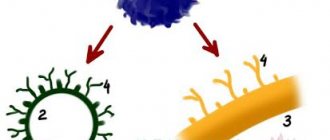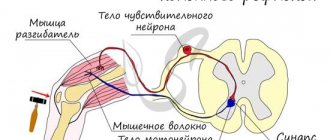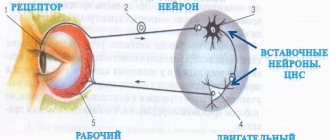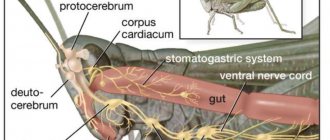The main task of the human body is to maintain a constant internal environment (i.e. homeostasis), as well as adaptation (i.e. adaptation) to the environment. These tasks are performed by 3 body systems: 1. The immune system, which is responsible for protecting against foreign genetic information. 2. The humoral (endocrine) system is responsible for the slow regulation of the activity of individual organs and tissues of the body. 3. The nervous system, which appeared later than the previous two; is responsible for the rapid and precise regulation of the activity of individual organs and tissues.
Content
- Functions of the nervous system
- NS departments
- Reflex as the basic principle of the nervous system
Neurophysiology views the nervous system as part of a living system that specializes in the transmission, analysis and synthesis of information, and neuropsychology as the material substrate of complex forms of mental activity, formed on the basis of the integration of various parts of the brain into functional systems.
The nervous system (NS) is a set of anatomically and functionally interconnected nervous structures that provide regulation and coordination of the activities of the human body and its interaction with the environment.
The structural unit of the NS is a cell with a process ( neuron , or neurocyte). The nervous system is a collection of neurons that communicate with each other through synapses.
Functions of the nervous system
The nervous system occupies a special position among other body systems. It ensures the relationship of the organism with the environment . Receptors respond to any signals from the external and internal environment, converting them into streams of nerve impulses that enter the central nervous system. Based on the analysis of the flow of nerve impulses encoding information, the brain forms an adequate response.
Together with the endocrine glands, the nervous system regulates the functioning of all organs . This regulation is carried out due to the fact that the spinal cord and brain are connected by nerves to all organs through bilateral connections. The central nervous system receives signals from the organs about their functional state, and the nervous system, in turn, sends signals to the organs, correcting their functions and ensuring all vital processes - movement, nutrition, excretion, etc. The nervous system ensures coordination of the activities of cells, tissues, organs , organ systems. In this case, the body functions as a single whole.
The nervous system is the material basis of mental processes : attention, memory, speech, thinking, etc., with the help of which a person not only learns about the environment, but can also actively change it.
Thus, several functions of the nervous system can be distinguished: 1. Connects the body with the environment (perception and transmission).
2. Provides interaction between tissues of organs and body systems and their regulation.
NS departments
Central nervous system and peripheral nervous system
According to topographical principles, the nervous system is divided into central and peripheral. The central nervous system (CNS) includes those parts that are contained in the cranial cavity and the spinal canal, i.e. brain and spinal cord. The spinal cord is a tube with a small canal in the middle, surrounded by neurons and their processes. The brain is an extension of the spinal cord. The topographic boundary with the spinal cord is a plane passing through the lower edge of the foramen magnum. The average brain weight is 1400 g with individual variations from 1100 to 2000 g.
The peripheral nervous system (PNS) includes all the nerve structures located outside of it. These are nodes and bundles of fibers that connect the central nervous system with sensory organs and various effectors (muscles, glands, etc.), i.e. ganglia and nerves. The peripheral nervous system connects the spinal cord and brain with receptors and effectors. It consists of 12 pairs of cranial and 31-33 pairs of spinal (spinal) nerves.
Somatic nervous system and autonomic nervous system
According to the functional classification, the nervous system is divided into somatic nervous system and autonomic nervous system. Both somatic and autonomic nervous systems include central and peripheral parts.
The somatic nervous system includes the parts of the nervous system that regulate the functioning of skeletal muscles. Responsible for connecting the body with the external environment, providing sensitivity and movement, causing contraction of skeletal muscles. It regulates primarily the functions of voluntary movement. Its neurons are located in the anterior horns of the spinal cord, and their axons through the anterior roots of the spinal cord are directed to the skeletal (striated) muscles.
The autonomic (autonomic) nervous system is a collection of nerves and ganglia through which the heart, blood vessels, internal organs, glands, etc. are regulated. Internal organs receive double innervation (supply of organs and tissues with nerves, which ensures their connection with the central nervous system) - from the sympathetic and parasympathetic divisions of the autonomic nervous system. These two departments have excitatory and inhibitory influences, determining the level of activity of the organs.
The vegetative nervous system provides metabolism, respiration, and excretion. Influencing the metabolic activity in various organs and tissues in accordance with the changing conditions of their functioning and the external environment, it carries out an adaptive-professional function.
The autonomic nervous system innervates smooth muscles; it is also called the visceral nervous system. The division of the peripheral nervous system into somatic and autonomic is quite arbitrary, since in the central nervous system there is a significant overlap of projections of both, and somatic and autonomic reactions are equal components of any behavioral reaction.
In the autonomic nervous system, there are 2 divisions that are functional antagonists : sympathetic and parasympathetic . They differ in the localization of centers in the brain and peripheral nodes, as well as the nature of the effect on internal organs.
Differences between sympathetic and parasympathetic nervous system
1. The fibers of the sympathetic nervous system emerge from the thoracic and lumbar spinal cord, where the first sympathetic neuron lies. They then converge on the sympathetic ganglia located along the spine, where the second sympathetic neuron is located. The fibers of the parasympathetic nervous system begin in the spinal cord above or below the place where the sympathetic nerves exit the cranial and sacral regions, and then converge in ganglia located not along the spinal column, but close to the innervated organ.
2. The peculiarities of the location of the ganglia of these two systems suggest a difference in the effect they have. The action of the sympathetic nervous system is more diffuse, while the parasympathetic nervous system is more specific, since it is associated only with changes in the organ next to which the ganglion is located.
3. These systems also differ in the mediators involved in synaptic transmission. The main transmitter for the sympathetic nervous system is adrenaline, and for the parasympathetic nervous system it is acetylcholine.
4. The results of the activity of these two systems are largely opposite. While the main function of the sympathetic nervous system is to mobilize the body for fight or flight, the parasympathetic nervous system primarily ensures the maintenance of homeostasis.
5. Activation of the sympathetic nervous system underlies the behavior of a person eager to fight. The stimulation of the parasympathetic nervous system ensures digestion in a person lying on the couch after a hearty lunch.
The sympathetic nervous system excites, and the parasympathetic nervous system inhibits the activity of the heart, the first weakens the motor activity of the intestines, the second strengthens it. At the same time, they can act at the same time: together they increase the motor activity of the salivary and gastric glands, although the composition of the secreted juice varies depending on the share of participation of each system.
Structure, functioning and properties of the central nervous system
The problem of the emergence of consciousness is considered from various positions. From one point of view, human consciousness is of divine origin.
Consciousness in humans is considered as a natural stage in the evolution of the animal world. Having familiarized ourselves with the material in the previous sections, we can say the following with some confidence:
• all living beings can be classified according to their level of mental development;
• the level of mental development of an animal is closely related to the level of development of its nervous system;
• a person, having consciousness, has the highest level of mental development.
Having made such conclusions, we will not be mistaken if we assert that a person has not only a higher level of mental development, but also a more developed nervous system.
In this section we will get acquainted with the structure and features of the functioning of the human nervous system. Let us immediately make a reservation that our acquaintance will not be of the nature of an in-depth study, since the functional structure of the nervous system is studied in more detail within the framework of other disciplines, in particular the anatomy of the nervous system, the physiology of higher nervous activity and psychophysiology.
The human nervous system consists of two sections: central
and
peripheral.
The central nervous system (CNS) consists of the brain and spinal cord. The brain consists, in turn, of the forebrain, midbrain and hindbrain. These main sections of the central nervous system also contain the most important structures that are directly related to the functioning of the human psyche: the thalamus, hypothalamus, pons, cerebellum, medulla oblongata.
Almost all departments and structures of the central and peripheral nervous system are involved in receiving and processing information, but the cerebral cortex is of particular importance for the human psyche.
which, together with the subcortical structures included in the forebrain, determines the characteristics of the functioning of human consciousness and thinking.
The central nervous system is connected to all organs and tissues of the human body. This connection is provided by nerves,
which come from the brain and spinal cord.
In humans, all nerves are divided into two functional groups. The first group includes nerves that conduct signals from the outside world and body structures. The nerves included in this group are called afferent.
Nerves that carry signals from the central nervous system to the periphery (organs, muscle tissue, etc.) are included in another group and are called
efferent.
The central nervous system itself is a collection of nerve cells - neurons.
These nerve cells consist of
a neuron
and tree-like processes called
depdrites.
One of these processes is elongated and connects the neuron with the bodies or processes of other neurons.
This process is called an axon.
Some axons are covered with a special sheath - the myelin sheath,
which ensures faster transmission of impulses along the nerve.
The places where one neuron connects to another are called synapses.
Most neurons are specific, that is, they perform specific functions. For example, neurons that carry impulses from the periphery to the central nervous system are called “sensory neurons.” In turn, the neurons responsible for transmitting impulses from the central nervous system to the muscles are called “motor neurons.” Neurons responsible for ensuring communication between one part of the central nervous system and another are called “local network neurons.”
At the periphery, axons connect to miniature organic devices designed to perceive various types of anergy (mechanical, electromagnetic, chemical, etc.) and convert this into the energy of a nerve impulse. These organic devices are called receptors.
They are located throughout the human body. There are especially many receptors in the senses, specifically designed to perceive information about the world around us.
While exploring the problem of perception, storage and processing of information, I. P. Pavlov introduced the concept of an analyzer.
This concept denotes a relatively autonomous organic structure that ensures the processing of specific sensory information and its passage
at all levels, including the central nervous system. Consequently, each analyzer consists of three structural elements: receptors, nerve fibers and the corresponding parts of the central nervous system.
As we have already said, there are several groups of receptors. This division of the pa group is recognized by the ability of receptors to perceive and process only one type of influence, therefore receptors are divided into visual, auditory, gustatory, olfactory, skin, etc. The information received with the help of receptors is transmitted further to the corresponding part of the central nervous system, including the cerebral cortex. It should be noted that information from identical receptors arrives only in a certain area of the cerebral cortex. The visual analyzer is connected to one part of the cortex, the auditory analyzer to another, etc.
It should be emphasized that the entire cerebral cortex can be divided into separate functional areas. In this case, it is possible to distinguish not only analyzer zones, but also motor, speech, etc. Thus, in accordance with K. Brodmann’s classification, the cerebral cortex can be divided into 11 regions and 52 fields.
Let's take a closer look at the structure of the cerebral cortex. It is the upper layer of the forebrain, formed mainly by vertically oriented neurons, their processes - dendrites and bundles of axons going down to the corresponding parts of the brain, as well as axons transmitting information from underlying brain structures. The cerebral cortex is divided into regions: temporal, frontal, parietal, occipital, and the regions themselves are divided into even smaller areas - fields. It should be noted that since the brain is divided into the left and right hemispheres, the areas of the cerebral cortex will accordingly be divided into left and right.
Based on the time of appearance of the sections of the cerebral cortex in the process of human phylogenesis, the cerebral cortex is divided into ancient, old and new. The ancient cortex has only one layer of cells, which are not completely separated from the subcortical structures. The area of the ancient cortex is approximately 0.6% of the area of the entire cerebral cortex.
The old cortex also consists of a single layer of cells, but it is completely separate from the subcortical structures. Its area is approximately 2.6% of the area of the entire cortex. Most of the cortex is occupied by the neocortex. It has the most complex, multi-layered and developed structure.
The information received by the receptors is transmitted along nerve fibers to a cluster of specific nuclei of the thalamus, and through them the afferent impulse enters the primary projection zones
cerebral cortex. These zones represent the final cortical structures of the analyzer. For example, the projective zone of the visual analyzer is located in the occipital regions of the cerebral hemispheres, and the projective zone of the auditory analyzers is in the upper parts of the temporal lobes.
The primary projective zones of the analyzers are sometimes called sensory zones because they are associated with the formation of a certain type of sensation. If any zone is destroyed, a person may lose the ability to perceive a certain type of information. For example, if the zone of visual sensations is destroyed, a person will go blind. Thus, a person’s sensations depend not only on the level of development and integrity of the sensory organ, in this case - vision, but also on the integrity of the pathways - nerve fibers - and the primary projective zone of the cerebral cortex.
It should be noted that in addition to the primary fields of the analyzers (sensory fields), there are other primary fields, for example, primary motor fields associated with the muscles of the body and responsible for certain movements. It is also necessary to pay attention to the fact that the primary fields occupy a relatively small area of the cerebral cortex - no more than one third of the part. A much larger area is occupied by secondary fields, which are most often called associative,
or
integrative.
The secondary fields of the cortex are like a “superstructure” over the primary fields. Their functions are to synthesize or integrate individual elements of information into a holistic picture. Thus, elementary sensations in sensory integrative fields (or perceptual fields) add up to a holistic perception, and individual movements, thanks to motor integrative fields, are formed into a holistic motor act.
Secondary fields play an extremely important role in ensuring the functioning of both the human psyche and the body itself. If these fields are influenced by electric current, for example, the secondary fields of the visual analyzer, then integral visual images can be evoked in a person, and their destruction leads to the disintegration of visual perception of objects, although individual sensations remain.
Among the integrative fields of the human cerebral cortex, it is necessary to distinguish speech centers differentiated only in humans: the center of auditory perception of speech
(the so-called
Wernicke's center)
and
the motor speech center
(the so-called
Broca's center).
The presence of these differentiated centers indicates the special role of speech for the regulation of the human psyche and behavior. However, there are other centers. For example, consciousness, thinking, behavior formation, volitional control are associated with the activity of the frontal lobes, the so-called prefrontal and premotor zones.
The representation of speech function in humans is asymmetrical. It is localized in the left hemisphere. This phenomenon is called functional asymmetry.
Asymmetry is characteristic not only of speech, but also of other mental functions. Today it is known that the left hemisphere in its work acts as the leader in the implementation of speech and other speech-related functions: reading, writing, counting, logical memory, verbal-logical, or abstract, thinking, voluntary speech regulation of other mental processes and states. The right hemisphere performs functions not related to speech, and the corresponding processes usually occur at the sensory level.
The left and right hemispheres perform different functions when perceiving and forming an image of the displayed object. The right hemisphere is characterized by high speed of recognition, its accuracy and clarity. This method of recognizing objects can be defined as integral-synthetic, predominantly holistic, structural-semantic, i.e. the right hemisphere is responsible for the holistic perception of an object or performs the function of global image integration. The left hemisphere functions on the basis of an analytical approach, which consists in sequentially enumerating the elements of the image, that is, the left hemisphere displays the object, forming individual parts of the mental image. It should be noted that both hemispheres are involved in the perception of the external world. Disruption of the activity of any of the hemispheres can lead to the impossibility of a person’s contact with the surrounding reality.
It is also necessary to emphasize that the specialization of the hemisphere occurs in the process of individual human development. Maximum specialization is observed when a person reaches maturity, and then, towards old age, this specialization is lost again.
When getting acquainted with the structure of the central nervous system, we must definitely stop at considering another brain structure - the reticular formation,
which plays a special role in the regulation of many mental processes and properties. It received this name - reticular, or reticular - because of its structure, since it is a collection of sparse, reminiscent of a fine network of neural structures, anatomically located in the spinal cord, medulla oblongata and hindbrain.
The reticular formation has a noticeable effect on the electrical activity of the brain, on the functional state of the cerebral cortex, subcortical centers, cerebellum and spinal cord. It is directly related to the regulation of basic life processes: blood circulation and respiration.
Very often, the reticular formation is called the source of activity of the body, since the nerve impulses generated by this structure determine the performance of the body, the state of sleep or wakefulness. It is also necessary to note the regulatory function of this formation, since the nerve impulses generated by the reticular formation differ in their amplitude and frequency, which leads to periodic changes in the functional state of the cerebral cortex, which, in turn, determines the dominant functional state of the whole organism. Therefore, the state of wakefulness is replaced by the state of sleep and vice versa.
Disturbance in the activity of the reticular formation causes disruption of the body's biorhythms. Thus, irritation of the ascending part of the reticular formation produces a reaction of change in the electrical signal, characteristic of the state of wakefulness of the body. Constant irritation of the ascending part of the reticular formation leads to the fact that a person’s sleep is disturbed, he cannot fall asleep, and the body shows increased activity. This phenomenon is called Resynchronization
and manifests itself in the disappearance of slow fluctuations in the electrical activity of the brain. In turn, the predominance of waves of low frequency and large amplitude causes prolonged sleep.
There is also an opinion that the activity of the reticular formation determines the nature of the response to the influence of objects and phenomena of the external world. It is customary to highlight specific
and
nonspecific
reactions of the body.
In a simplified form, a specific reaction is the body’s usual reaction to a familiar, or standard, stimulus. The essence of a specific reaction is the formation of standard adaptive
forms of response to a familiar external stimulus.
A nonspecific reaction is the body's reaction to an unusual external stimulus. The unusualness may lie both in the excess of the strength of the usual stimulus, and in the nature of the impact of a new unknown stimulus. In this case, the body’s response is indicative
in nature. Thanks to the presence of this type of reaction, the body has the opportunity to subsequently form an adequate adaptive response to a new stimulus, which preserves the integrity of the body and ensures its further normal functioning.
Thus, we can state that the human nervous system performs the functions of a system that regulates the activities of the entire organism. Thanks to the nervous system, a person is able to receive information about the external environment, analyze it and form behavior appropriate to the situation, that is, successfully adapt to changing environmental conditions.
The relationship between the human psyche and brain. In the 4th century. BC e. Alcmaeon of Croton formulated the idea that mental phenomena are closely related to the functioning of the brain. This idea was supported by many ancient scientists, such as Hippocrates. The idea of the relationship between the brain and the psyche has developed throughout the history of the accumulation of psychological knowledge, as a result of which more and more new variants have appeared
At the beginning of the 20th century. from two different areas of knowledge - psychology and physiology - two new sciences were formed: the physiology of higher nervous activity
and
psychophysiology.
The physiology of higher nervous activity studies the organic processes occurring in the brain and causing various bodily reactions. Psychophysiology, in turn, studies the anatomical and physiological foundations of the psyche.
It should be immediately recalled that the problems of psychophysiology and the fundamentals of the physiology of higher nervous activity are studied in more detail within the framework of courses in psychophysiology and normal physiology. In this section, we consider the problem of the relationship between the brain and the psyche in order to gain a general understanding of it, in order to obtain a holistic understanding of the human psyche.
I. M. Sechenov made a great contribution to understanding how the work of the brain and human body is connected with mental phenomena and behavior. Later, his ideas were developed by I.P. Pavlov, who discovered the phenomenon of conditioned reflex learning.
Nowadays, Pavlov's ideas and developments have served as the basis for the creation of new theories, among which stand out the theories and concepts of N. A. Bernstein, K. Hull, P. K. Anokhin, E. N. Sokolov and others.
I.M. Sechenov believed that mental phenomena are included in any behavioral act and themselves represent unique complex reflexes, that is, physiological phenomena. According to I.P. Pavlov, behavior consists of complex conditioned reflexes formed during the learning process. Later it turned out that the conditioned reflex is a very simple physiological phenomenon and nothing more. However, despite the fact that after the discovery of conditioned reflex learning, other ways of acquiring skills by living beings were described - imprinting, operant conditioning, vicarious learning, the idea of a conditioned reflex as one of the ways of acquiring experience was preserved and was further developed in the works of such psychophysiologists as E. N. Sokolov and Ch. I. Izmailov. They proposed the concept of a conceptual reflex arc,
consisting of three interconnected, but relatively independent systems of neurons: afferent (sensory analyzer), effector (executive, responsible for the organs of movement) and modulatory (controlling connections between the afferent and effector systems). The first system of neurons ensures the receipt and processing of information, the second system ensures the generation of commands and their execution, the third system exchanges information between the first two.
Along with this theory, there are other, very promising developments concerning, on the one hand, the role of mental processes in the control of behavior, and on the other, the construction of general models of behavior regulation with the participation of physiological and psychological phenomena in this process. Thus, N.A. Bernstein believes that even the simplest acquired movement, not to mention complex human activity and behavior in general, cannot be performed without the participation of the psyche. He argues that the formation of any motor act is an active psychomotor reaction. In this case, the development of movement is carried out under the influence of consciousness, which at the same time carries out a certain sensory correction of the nervous system, ensuring the execution of a new movement. The more complex the movement, the more corrective changes are required. When the movement is mastered and brought to automatism, the control process leaves the field of consciousness and turns into the background.
The American scientist K. Hull considered a living organism as a self-regulating system with specific mechanisms of behavioral and genetic-biological regulation. These mechanisms are mostly innate and serve to maintain optimal conditions of physical and biochemical balance in the body - homeostasis -
and come into action when this balance is disturbed.
P.K. Anokhin proposed his concept of regulation of behavioral acts. This concept has become widespread and is known as the functional system
.
The essence of this concept is that a person cannot exist in isolation from the world around him. He is constantly exposed to certain environmental factors. The influence of external factors was called by Anokhin situational afferentation.
Some influences are insignificant or even unconscious for a person, but others, usually unusual, cause a response in him.
This response is in the nature of an indicative reaction
and is a stimulus for activity.
All objects and conditions of activity affecting a person, regardless of their significance, are perceived by a person in the form of an image.
This image correlates with information stored in memory and a person’s motivational attitudes. Moreover, the process of comparison is carried out, most likely, through consciousness, which leads to the emergence of a decision and a plan of behavior.
In the central nervous system, the expected outcome of actions is presented in the form of a peculiar nervous model, called by Anokhin the acceptor of the result of an action.
The acceptor of the result of an action is the goal towards which the action is directed. In the presence of an action acceptor and an action program formulated by consciousness, the direct execution of the action begins. This involves the will, as well as the process of obtaining information about the fulfillment of the goal. Information about the results of an action has the nature of feedback (reverse afferentation) and is aimed at forming an attitude towards the action being performed. Since information passes through the emotional sphere, it causes certain emotions that influence the nature of the attitude. If the emotions are positive, then the action stops. If emotions are negative, then adjustments are made to the execution of the action.
The theory of functional systems by P.K. Anokhin has become widespread due to the fact that it allows us to get closer to solving the issue of the relationship between physiological and psychological processes. This theory suggests that mental phenomena and physiological processes play an important role in the regulation of behavior. Moreover, behavior is in principle impossible without the simultaneous participation of mental and physiological processes.
There are other approaches to considering the relationship between the psyche and the brain. Thus, A. R. Luria proposed to identify anatomically relatively autonomous blocks of the brain that provide (the functioning of mental phenomena. The first block is designed to maintain a certain level of activity. It includes the reticular formation of the brain stem, the deep parts of the midbrain, the structures of the limbic system, the mediobasal cortex frontal and temporal lobes of the brain. The second block is associated with cognitive mental processes and is intended for the processes of receiving, processing and storing information. This block consists of areas of the cerebral cortex, which are mainly located in the posterior and temporal parts of the cerebral hemispheres. The third block provides thinking functions , behavioral regulation and self-control.The structures included in this block are located in the anterior parts of the cerebral cortex.
This concept was put forward by Luria as a result of an analysis of the results of his experimental studies of functional and organic disorders and diseases of the brain. However, it should be noted that the problem of localizing mental functions and phenomena in the brain is interesting in itself. At one time, the idea was put forward that all mental processes are associated with certain areas of the brain, that is, localized.
According to the idea
of localism,
each mental function can be “tied” to a specific organic part of the brain. As a result, detailed maps of the localization of mental functions in the brain were created.
However, after a certain time, facts were obtained indicating that various disorders of mental processes are often associated with damage to the same brain structures, and vice versa, damage to the same areas in certain cases can lead to different disorders. The presence of such facts led to the emergence of an alternative hypothesis - anti-localizationism,
— asserting that the work of individual mental functions is connected with the activity of the entire brain. From the point of view of this hypothesis, certain connections have developed between different parts of the brain that ensure the functioning of certain mental processes. But this concept could not explain many brain disorders that speak in favor of localizationism. Thus, disruption of the occipital parts of the cerebral cortex leads to vision damage, and the temporal lobes of the cerebral hemispheres lead to speech impairment.
The problem of localizationism-antilocalizationism
has not yet been resolved.
We can say with complete confidence that the organization of brain structures and the relationship between individual parts of the brain is much more complex and multifaceted than the currently available information about the functioning of the central nervous system. We can also say that there are areas of the brain that are directly related to certain sensory organs and movements, as well as the implementation of abilities inherent in humans (for example, speech). However, it is likely that these areas are to a certain extent interconnected with other parts of the brain, which ensure the implementation of a particular mental process in full. Psychophysiological problem in psychology. Considering the relationship between the psyche and the brain, we cannot help but get acquainted with the so-called psychophysiological problem. Speaking about the natural scientific foundations of the psyche, today we have no doubt that there is a certain relationship between the psyche and the brain. However, even today the problem, known since the end of the 19th century, continues to be discussed. as psychophysiological. It is an independent problem of psychology and is not specifically scientific, but methodological in nature. It is related to the solution of a number of fundamental methodological issues, such as the subject of psychology, methods of scientific explanation in psychology, etc. What is the essence of this problem? Formally, it can be expressed in the form of a question: how are physiological and mental processes related? There are two main answers to this question. The first was stated in a naive form by R. Descartes, who believed that there is a pineal gland in the brain, through which the soul influences animal spirits, and animal spirits influence the soul. Or, in other words, the mental and physiological are in constant interaction and influence each other. This approach is called the principle of psychophysiological interaction. The second solution is known as the principle of psychophysiological parallelism. Its essence is to assert the impossibility of causal interaction between mental and physiological processes. At first glance, the truth of the first approach, which consists in the affirmation of psychophysiological interaction, is beyond doubt. We can give many examples of the impact of physiological processes of the brain on the psyche and the psyche on physiology. Yet, despite the evidence of psychophysiological interaction, there are a number of serious objections to this approach. One of them is the denial of the fundamental law of nature - the law of conservation of energy. If material processes, such as physiological processes, were caused by a mental (ideal) cause, then this would mean the emergence of energy from nothing, since the mental is not material. On the other hand, if physiological (material) processes gave rise to mental phenomena, then we would be faced with a different kind of absurdity - energy disappears. Of course, one can object to this that the law of conservation of energy is not entirely correct, but in nature we are unlikely to find other examples of violation of this law. We can talk about the existence of specific “psychic” energy, but in this case it is again necessary to explain the mechanisms of transformation of material energy into some kind of “immaterial” energy. And finally, we can say that all mental phenomena are material in nature, that is, they are physiological processes.
Then the process of interaction between soul and body is the process of interaction between material and material. But in this case, it is possible to reach an agreement to the point of complete absurdity. For example, if I raised my hand, then this is an act of consciousness and at the same time a cerebral physiological process. If after this I want to hit someone with it (for example, my interlocutor), then this process can go to the motor centers. However, if moral considerations force me to refrain from doing this, then this means that moral considerations are also a material process. At the same time, despite all the reasoning given as evidence of the material nature of the psyche, it is necessary to agree with the existence of two phenomena - subjective (primarily the facts of consciousness) and objective (biochemical, electrical and other phenomena in the human brain). It would be quite natural to assume that these phenomena correspond to each other. But if we agree with these statements, then we go over to the side of another principle - the principle of psychophysiological parallelism, which asserts the impossibility of interaction between ideal and material processes.
It should be noted that there are several streams of parallelism. This is dualistic parallelism, which comes from the recognition of the independent essence of the spiritual and material principles, and monistic parallelism, which sees all mental and physiological phenomena as two sides of one process. The main thing that unites them is the assertion that mental and physiological processes proceed in parallel and independently of each other. What happens in the mind corresponds to what happens in the brain, and vice versa, but these processes are independent of each other.
We could agree with this statement if reasoning in this direction were not constantly clogged with denial of the existence of the psyche. For example, a brain process independent of the psyche is most often triggered by a push from the outside: external energy (light rays, sound waves, etc.) is transformed into a physiological process, which is transformed in pathways and centers and takes the form of reactions, actions, and behavioral acts. Along with this, without influencing him in any way, events unfold on the conscious plane - images, desires, intentions. At the same time, the mental process does not in any way affect physiological processes, including behavioral reactions. Consequently, if the physiological process does not depend on the mental one, then all human life activity can be described in terms of physiology. In this case, the psyche becomes an epiphenomenon—a side effect.
Thus, both approaches we are considering are unable to solve the psychophysiological problem. Therefore, there is no single methodological approach to the study of psychological problems. From what position will we proceed when considering mental phenomena?
From the above it follows that there is a close connection between mental and physiological processes. Therefore, when considering mental phenomena, we will always remember that they are in close interaction with physiological processes, that they most likely determine each other. At the same time, the human brain is the material “substrate” that provides the possibility of the functioning of mental phenomena and processes. Therefore, mental and physiological processes are interconnected and mutually determine human behavior.
Reflex as the basic principle of the nervous system
I. M. Sechenov in 1863 in his work “Reflexes of the Brain” he developed the idea that the reflex is the basic principle of the functioning of not only the spinal cord, but also the brain.
A reflex is the body’s response to irritation with the participation of the central nervous system. Reflexes are divided into: 1) unconditioned reflexes: innate (hereditary) reactions of the body to stimuli carried out with the participation of the spinal cord or brain stem; 2) conditioned reflexes: temporary reactions of the body acquired on the basis of unconditioned reflexes, carried out with the obligatory participation of the cerebral cortex, which form the basis of higher nervous activity.
Each reflex has its own reflex arc - this is the path along which excitation passes from the receptor to the effector (executive organ).
The reflex arc is represented by a chain of neurons that provide the perception of irritation, the transformation of the energy of irritation into a nerve impulse, the conduction of a nerve impulse to the nerve centers, the processing of incoming information and the implementation of a response.
Any reflex arc consists of 5 components
1. A receptor is a specialized cell designed to perceive a stimulus (sound, light, chemical, etc.). 2. Afferent pathway, which is represented by afferent neurons. 3. Part of the central nervous system, represented by the spinal cord or brain; 4. The efferent pathway consists of the axons of efferent neurons extending beyond the CNS. 5. An effector is a working organ (muscle, gland, etc.).
The simplest reflex arc includes 2 neurons and is called monosynaptic (based on the number of synapses). A more complex one is represented by 3 neurons and is called three-neuron or disynaptic. However, most reflex arcs include a large number of interneurons and are called polysynaptic.
Reflex arcs can pass through the spinal cord only (for example, withdrawing a hand when touching a hot object) or through the brain only (for example, closing the eyelids when a stream of air is directed at the face), or through both the spinal cord and the brain.
Reflex arcs are closed into reflex rings using feedback connections. The concept of feedback and its functional role was indicated by Bell in 1826. He wrote that two-way connections are established between the muscle and the central nervous system. With the help of feedback, signals about the functional state of the effector are sent to the central nervous system.
The morphological basis of feedback is the receptors located in the effector and the afferent neurons associated with them. Thanks to feedback afferent connections, fine regulation of the effector’s work and an adequate response of the body to environmental changes are carried out.
Methods for studying the central nervous system and its functions
All research methods are associated with the intensive development of the physiology of the central nervous system. They are divided into the following types:
- Destructive method . It is associated with the study of which types of functions are preserved and which ones are lost after surgical intervention. Accompanied by significant changes in the body and central nervous system.
- Cutting . Using this method, you can study the significance of any department of the central nervous system and the influence of other departments on it. Produced at any level of the central nervous system.
- Irritation . Using this method, you can see what the functional significance is for various formations of the central nervous system.
- Electrographic . This method, in turn, is divided into the following subtypes: electroencephalography, local potential abduction, evoked potentials.
- Reflex studies.
- Biochemical research.
- Pharmacological.
Reflexes
Reflex is a response of the body to any action of a stimulus, which is carried out with the participation of the central nervous system. When translated from Latin, this term means “display.” This term was discovered by the scientist R. Descartes in order to characterize the body's reaction to respond to irritation of the senses.
Reflexes are classified into the following subtypes depending on their type:
- Origin: congenital (unconditional) and acquired (conditional);
- Receptors: exteroceptive, interoceptive, proprioceptive;
- Biological: defensive, sexual, nutritional;
- Effectors: vasomotor, secretory, motor;
- Level of closure: cortical, subcortical, mesencephalic, bulbar, spinal;
- Axon reflex: a reflex group that, without the participation of the body, is carried out along axon branches;
- Functional: synergistic and antagonistic;
- Reflex path complexity: polysynaptic and monosynaptic;
- Vegetative - participate in regulating the activity of secretion glands (internal), blood vessels, internal organs;
- Somatic - reveal themselves in the form of muscle contraction (phasic) and in tonic changes;
- Adaptation-trophic: viscero-motor, viscero-visceral, viscero-cutal.
Properties of the centers of the nervous system
A nerve center is a collection of neurons that will take part in the work of one specific reflex of the body. Throughout the body, in order to form an adaptive complex process, a functional reconnection of neurons is carried out, which are located at different levels of the central nervous system.
Nerve centers have a number of features and properties . These include:
- Excitation is one-sided - to the working organ from the receptor.
- In nerve centers, excitation manifests itself more slowly than along nerve fibers.
- The summation of excitations also occurs in the nerve centers. It can be sequential, simultaneous or temporary.
- Transformation to the rhythm of excitement. It is a change in the number of impulses that leave the nerve centers compared to the number that leads to it. May manifest itself in an increase or decrease in the number of impulses.
- The aftereffect of reflexes is the cessation of the reaction a little later compared to the action of the pathogen.
- Increased sensitivity to substances of chemical origin and oxygen deficiency.
- Nerve centers get tired quickly and have a low level of locality, and are easily inhibited.
- Nerve centers have a plastic structure - they can change their functional purpose and partially restore functions that have been lost.
Principles in Central Nervous System Coordination
The basis of the coordination activity of the nervous system is the interaction of the processes of inhibition and excitation. There are a number of principles that ensure coordination interaction:
- The principle of dominance . It can be characterized by the following properties: inertia of excitation, increased level of excitability, summation of excitations, inhibition of subdominant foci of excitations emanating from other centers.
- The principle of occlusion . The idea behind this principle is that a pair of afferent inputs together excite a smaller group of motoneurons compared to the effect of activating them separately.
- The principle of reverse order communication . The process of self-regulation in the body is fully realized only when the reverse communication channel is fully functioning.
- The principle of reciprocity (mutuality, conjugation). Displays the relationships between those centers that are responsible for the implementation of functions that are opposite.
- The principle of a finite common path . Effector neurons of the central nervous system are involved in the implementation of various excitation reactions in the body, which lead to them a large number of intermediate and afferent neurons, for which they will serve as the final pathway.
- Phenomena of convergence . This is a process in which nerve impulses converge on one central neuron.
- Phenomena of divergence . This is a process in which impulses diverge into neighboring areas.
- Relationships are subordinate . The process by which the upper parts of the central nervous system influence the lower parts of the central nervous system.









